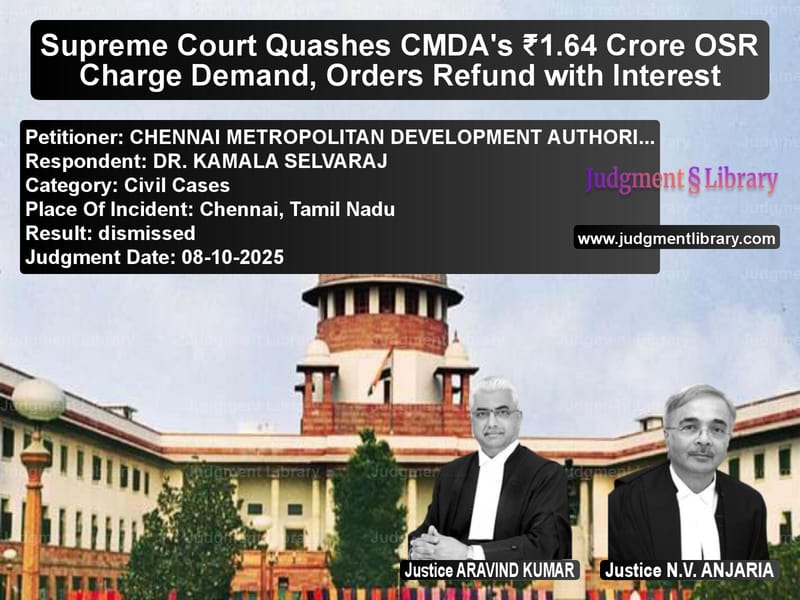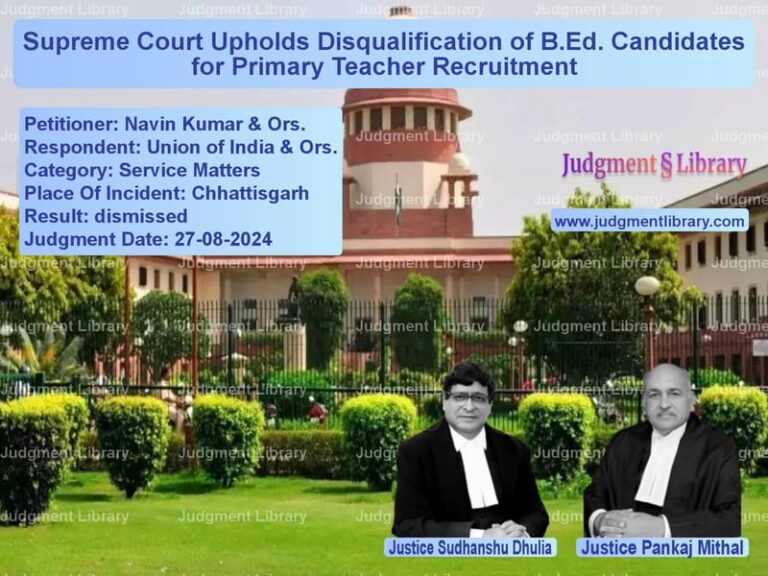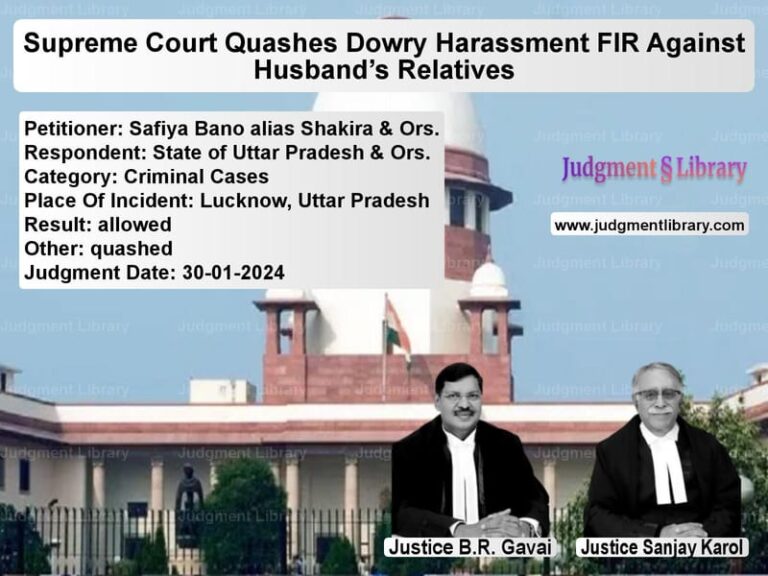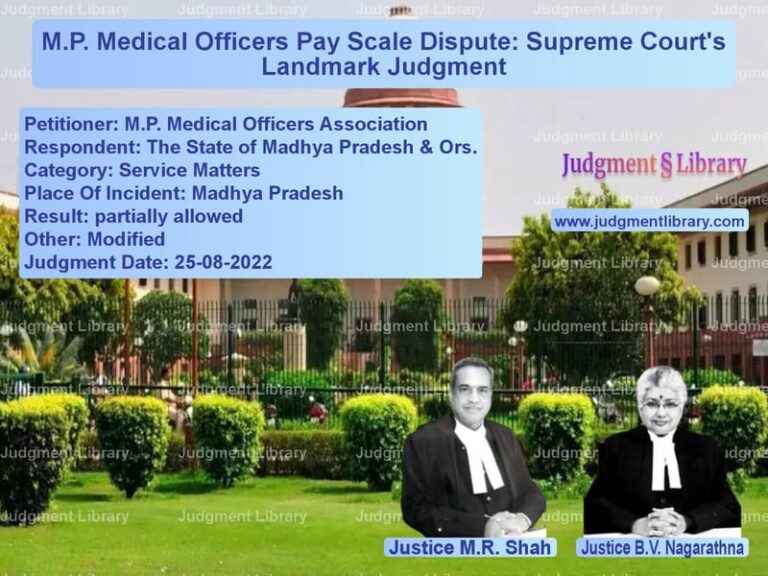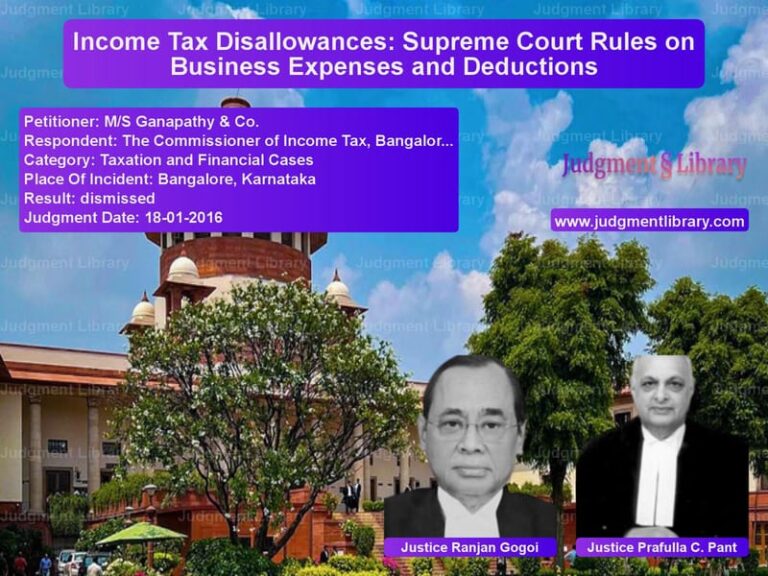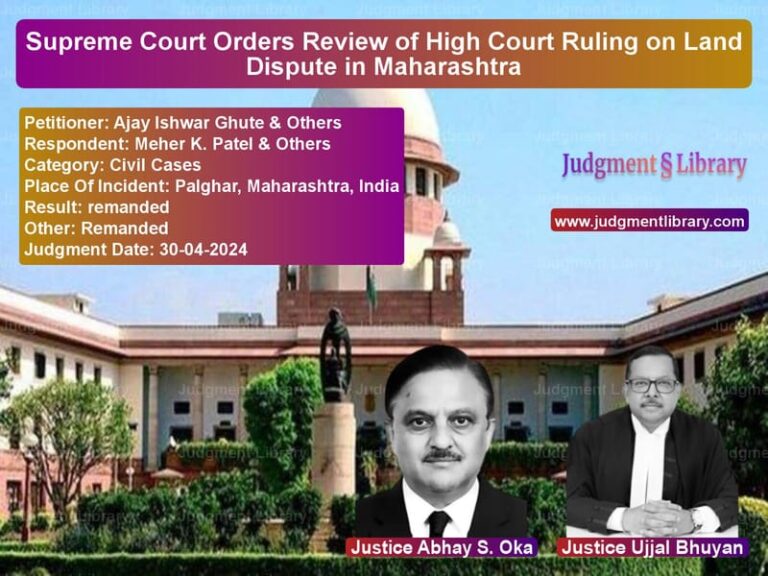Supreme Court Quashes CMDA’s ₹1.64 Crore OSR Charge Demand, Orders Refund with Interest
In a significant victory for property rights and regulatory clarity, the Supreme Court of India has delivered a landmark judgment that protects property owners from arbitrary development charges. The case involved a substantial financial dispute where the Chennai Metropolitan Development Authority (CMDA) had demanded ₹1.64 crore from Dr. Kamala Selvaraj as Open Space Reservation (OSR) charges for her property in Chennai’s Nunganbakkam area. What began as a routine application for building permission transformed into a legal battle that would test the boundaries of urban development regulations and their application to historically subdivided properties.
The story of this property dispute traces back to the mid-20th century, beginning with the estate of Haji Syed Ali Akbar Ispahani. Following his death, his heirs executed a registered partition deed in April 1949, dividing the family properties. Through this partition, an extent of about twenty-one grounds in Survey No. 126/2 of Nunganbakkam Village was allotted to Syed Jawad Ispahani, one of the sons. This initial division set the stage for the complex property history that would become central to the legal dispute decades later.
In the years that followed, the Ispahani family members dealt with their shares through a series of registered conveyances. The crucial transactions occurred in 1972 and 1973 when Syed Jawad Ispahani gifted two parcels measuring 5¼ grounds and 5¾ grounds to his son Syed Ali Ispahani through registered gift deeds. These transactions, completed years before the First Master Plan came into force on August 5, 1975, resulted in Syed Ali Ispahani holding eleven grounds of land as his independent property. The significance of these pre-1975 transactions cannot be overstated, as they would later become the foundation for challenging CMDA’s demand.
The property’s history continued to evolve when in 1984, Syed Ali Ispahani gifted a small portion of 125 square feet to a charitable organization, leaving him with approximately ten grounds. This remaining portion became the subject of the dispute when Dr. Kamala Selvaraj, a medical professional intending to establish a super-speciality hospital, purchased the property from Syed Ali Ispahani in February 2008 through a registered sale deed.
After her purchase, Dr. Selvaraj applied to CMDA for planning permission in January 2009. Her application faced initial rejection based on Regulation 26(2) of the Development Regulations, but the State Government intervened by granting exemption subject to technical conditions. However, CMDA then demanded ₹1.64 crore as OSR charges calculated in lieu of land. Dr. Selvaraj protested this demand, pointing out that her site measured only 2229 square meters, well below the 3000 square meter threshold that would exempt it from OSR charges under Annexure XX of the Development Regulations.
When CMDA rejected her representation and insisted on payment, Dr. Selvaraj found herself in a difficult position. To avoid further delays in her hospital project, she deposited the demanded amount under protest in April 2010 while simultaneously approaching the High Court under Article 226 of the Constitution. Both the Single Judge and Division Bench of the High Court ruled in her favor, declaring the levy unsustainable and directing refund with interest. CMDA’s appeal against these decisions brought the matter before the Supreme Court.
The Legal Battle Intensifies
Before the Supreme Court, the arguments from both sides reflected fundamentally different interpretations of property law and development regulations. Shri Balaji Subramaniam, representing CMDA, made several key arguments. He contended that “the High Court had erred in overlooking the fact that the respondent’s holding formed part of a larger property measuring twenty-one grounds, equivalent to about 4682 square metres.” He urged that “the purchase of 2008 amounted to a fresh sub-division and, therefore, Regulation 29 of the Development Regulations was attracted.” Furthermore, he submitted that “the exemption contemplated for sites below 3000 square metres could not be claimed, since the parent holding was above the threshold.” Lastly, he argued that “pattas or private family arrangements cannot take the place of statutory sub-division approval, and that the levy of OSR charges was, therefore, valid.”
On the other side, Shri Vikas Mehta, representing Dr. Selvaraj, supported the reasoning of the lower courts. He submitted that “the documentary trail commencing with the partition deed of 1949, followed by the gift deeds of 1972 and 1973, conclusively established that the respondent’s vendor held an independent parcel of 11 grounds long before 1975.” He emphasized that “the issuance of separate pattas, placed the matter beyond the pale of controversy.” He further argued that “the argument that the purchase constituted a fresh sub-division was wholly misconceived” and that “Annexure XX of the Development Regulations, by its plain terms, exempts the first 3000 square metres, and since the respondent’s site is 2229 square metres, no OSR is leviable.”
The Supreme Court’s Analysis
The Supreme Court, comprising Justices Aravind Kumar and N.V. Anjaria, delivered a comprehensive analysis that addressed both the factual history and legal principles involved. The Court noted that “the fulcrum of the appellant’s case rests on the proposition that the property must be viewed with reference to the parent extent of 21 (twenty-one) grounds and that the sub-division occurred only in 2008 namely after regulation coming into force.” However, the Court found “no merit in this contention.”
The judgment extensively examined the documentary evidence, observing that “the partition deed dated 23.04.1949 (Doc. No. 6119/1949) clearly disclose 21 (twenty-one) grounds in Survey No. 126/2, Nungambakkam Village, was allotted to Syed Jawad Ispahani.” The Court emphasized that the subsequent gift deeds from 1972 and 1973 were “executed years prior to 05 August 1975, are unimpeached, form part of the record, and signify a lawful familial conveyance or arrangement.”
The Court placed significant weight on the issuance of separate pattas, noting that “in pursuance of these gifts, separate pattas were issued recognising 11(eleven) grounds and 52 sq. ft. in the name of Syed Ali Ispahani.” The judges observed that “the issuance of pattas, a public act of the revenue authority, evidences official acknowledgment of an independent parcel.” They further stated that “it is well settled that revenue entries, though not constituting title, corroborate possession and demarcation, and when read alongside registered conveyances, they establish the existence of a separate holding.”
Burden of Proof and Regulatory Interpretation
The Supreme Court made important observations about the burden of proof in such cases. The Court held that “once this series of registered deeds and pattas were produced and the initial evidentiary burden was discharged, same shifted to the appellant–Authority to establish that, notwithstanding these instruments, the property was not lawfully sub-divided prior to 05 August 1975.” The Court found that “this burden has not been discharged.”
The judgment was particularly critical of CMDA’s approach, stating that “the appellant’s bald assertion that sub-division occurred in 2008 is a mere ipse dixit, devoid of proof, and cannot prevail over contemporaneous registered instruments whose authenticity is not in dispute.” The Court affirmed that “the High Court was right in relying upon these materials to hold that the sub-division existed prior to 1975 and same cannot be faulted.”
On the interpretation of the Development Regulations, the Court was unequivocal: “On the second limb, Annexure XX of the Development Regulations is categorical: ‘for the first 3000 square metres — Nil.’ The respondent’s holding being 2229 square metres falls squarely within the Nil slab.” The Court rejected CMDA’s attempt to “recombine it notionally with the erstwhile 21-ground parent estate” as being “contrary both to fact and to the text of the regulation.” The judges warned that “to accept such a construction would be to ignore the legislative exemption and retroactively enlarge the liability.”
Broader Implications and Final Directions
The Supreme Court also noted an important factual aspect that strengthened Dr. Selvaraj’s case: “The High Court was also correct in observing that the respondent had not formed any layout. Consequently, there was no occasion to invoke provisions meant for layout promoters. The respondent merely sought to develop her site by constructing a hospital.”
In its concluding remarks, the Supreme Court emphasized the limited scope of its jurisdiction under Article 136, stating that “this Court has consistently held that in the exercise of jurisdiction under Article 136, interference is warranted only where manifest illegality, perversity, or grave miscarriage of justice is demonstrated.” The Court found that “no such infirmity is made out here.”
The final judgment dismissed CMDA’s appeal and affirmed the High Court’s direction to refund the ₹1.64 crore with 8% interest. The Court specifically directed that “the direction of the High Court to refund the sum of ₹1,64,50,000/– (Rupees One Crore Sixty Four Lakhs Fifty Thousand Only) with interest at 8% per annum, to the extent not already complied with, shall stand affirmed and appellant is directed to pay the said amount to the respondent(s) within six (6) weeks from today.”
Conclusion
This judgment represents a significant precedent in urban development law, particularly regarding the application of OSR charges and the recognition of historical property subdivisions. The Supreme Court’s firm stance on requiring concrete evidence rather than bald assertions from regulatory authorities reinforces the principle that government actions must be based on substantiated facts rather than arbitrary assumptions.
The decision also provides much-needed clarity for property owners who acquire parcels that were subdivided before modern development regulations came into force. By affirming that such historical subdivisions must be recognized and that exemptions under development regulations should be applied based on the current holding rather than some notional ancestral estate, the Court has protected property rights from retrospective regulatory overreach.
For urban development authorities across India, this judgment serves as a reminder that while they have important regulatory functions to perform, their demands must be grounded in legal provisions and supported by evidence. The Court’s emphasis on the plain text of regulations and its rejection of creative reinterpretations that would expand liability retroactively establishes important boundaries for regulatory authority.
As Indian cities continue to grow and develop, this judgment will likely be cited frequently in disputes involving development charges, property subdivisions, and the application of exemptions under urban planning regulations. It stands as a testament to the judiciary’s role in ensuring that regulatory power is exercised reasonably and in accordance with established legal principles.
Petitioner Name: CHENNAI METROPOLITAN DEVELOPMENT AUTHORITY.Respondent Name: DR. KAMALA SELVARAJ.Judgment By: Justice ARAVIND KUMAR, Justice N.V. ANJARIA.Place Of Incident: Chennai, Tamil Nadu.Judgment Date: 08-10-2025.Result: dismissed.
Don’t miss out on the full details! Download the complete judgment in PDF format below and gain valuable insights instantly!
Download Judgment: chennai-metropolitan-vs-dr.-kamala-selvaraj-supreme-court-of-india-judgment-dated-08-10-2025.pdf
Directly Download Judgment: Directly download this Judgment
See all petitions in Property Disputes
See all petitions in Contract Disputes
See all petitions in Damages and Compensation
See all petitions in Consumer Rights
See all petitions in Landlord-Tenant Disputes
See all petitions in Judgment by Aravind Kumar
See all petitions in Judgment by N.V. Anjaria
See all petitions in dismissed
See all petitions in supreme court of India judgments October 2025
See all petitions in 2025 judgments
See all posts in Civil Cases Category
See all allowed petitions in Civil Cases Category
See all Dismissed petitions in Civil Cases Category
See all partially allowed petitions in Civil Cases Category

